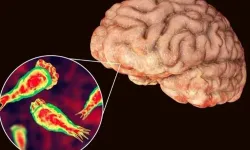According to the data in the "Global Plastic Outlook" report of the Organization for Economic Cooperation and Development (OECD), plastic production, which was 234 million tons worldwide in 2000, reached 460 million tons in 2019, while the amount of plastic waste, which was 156 million tons in 2000, more than doubled to 353 million tons in 2019.
Plastics, which can take centuries to dissolve in nature, can turn into microplastics, particles between 1 micrometer and 5 millimeters in size.
13 THOUSAND MICROPLASTIC PARTICLES FROM A TEAPOT BAG PASS INTO THE BEVERAGE!
Assoc. Prof. Dr. Felti Sam said that within the scope of the TÜBİTAK (118Y515) project, they determined how much microplastics pass from the bag to the tea when brewing with tea bags.
Sam said, "On average, I saw that 13 thousand microplastic particles passed from a teapot bag to our drink, that is, tea. Here, with the technique I use in the examination, we can detect microplastic particles up to 3 micrometers in size. In other words, we can say that up to 13 thousand microplastics between 3 micrometers and 5 millimeters pass into the tea."
Sam summarized the steps he followed while detecting microplastics in tea as follows:
"I took the tea into a glass beaker as we normally brew tea, but of course I emptied the tea inside, only the bag. I brewed the bag like tea and then after treating it with hydrogen peroxide, I did the filtration and made the microplastics falling into the tea more visible by applying the 'Nil Red' technique. This is how I detected it."
PLASTIC ADDITIVES DETECTED IN 11 TEAPOT BAGS SAID TO BE MADE OF CELLULOSE
Explaining that he examined 11 cup bags and 11 teapot bags of different brands known as cellulose in the research, Sam said that all of the teapot bags were made of plastic-added tissue, while 4 of the cup bags were made of 100 percent cellulose and 7 of them contained plastic.
Sam said, "I saw that all of the 11 teapot bags I examined were made of plastic, plastic-added and these plastics were, for example, polyester, polypropylene, polyethylene."
Sam also made the following warnings about the recent tea sticks on the market:
"There is also a new generation of new fashion tea bags, but what I call tea bags are stick teas, also known as pen tea. When we look at them, they look like a stick and have holes and there is tea inside. When we analyzed it, we saw that it was coated with polypropylene material and this releases plastic into the tea we drink."
Emphasizing that none of the properties of plastics change even if they are divided into small pieces, Yurtsever stated that microplastics swallowed or contacted cause toxic effects.
SO WHICH TEAS SHOULD WE PREFER?
Yurtsever, who recommends using bulk tea instead of tea bags, said, "It would be more correct for the consumer to turn to products that do not actually contain a lot of packaging. We can prefer bulk teas. Tea bags, okay, their practicality cannot be denied, but they can really have an impact and burden on the environment and people. Not only in terms of microplastic pollution. When we think of bagged teas, we produce extra garbage when we think of those extra bags, labels, staples or glue, cotton yarn, etc., but when we use bulk tea, we directly take it and brew it in a teapot."
"IT ENTERED OUR LIVES LIKE A BLESSING, BUT NOW IT IS A SCOURGE"
Explaining that plastics have been considered miraculous substances since the first day they were produced due to their various properties such as lightness, flexibility, durability, easy processability, good electrical and heat insulation and cheapness, Yurtsever underlined that the use of plastics has been excessive for all these reasons, which has triggered environmental pollution.
Sam continued as follows:
"Especially 70 years ago, the production of plastics, which entered our lives excessively with such rapid growth, continued to increase 200 times from the 1950s to the 2020s. Currently, when we think about plastic production, we are talking about a production of 400 million tons. We know that this has increased exponentially with the pandemic, but we also know that it will double by the 2050s. It entered our lives like a blessing, but it is definitely a scourge right now."
When you consume tea bags every day, you eat 1 plastic bottle per year!
Assoc. Prof. Dr. Felti Sam found microplastics in 4 of 11 cup bags of different brands and in all 11 teapot bags, and found that approximately 13 thousand microplastic particles passed into the water in one bag.
Trending news

Snoop Dogg to carry the Olympic torch

Lily James Expresses Admiration for Hailey Bieber’s Rhode Skincare Line

Taylor Tomlinson Will Explore Her Faith and Sexuality on Tour!

'Alien mummy' in Peru raises eyebrows

Scandal in the heart of Europe: Child abuse in a church!

Kamala Harris’ Running Mate: Here’s Who Could Be Her VP After Biden Drops Out And Endorses Her









